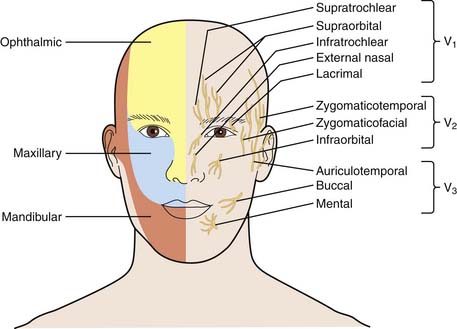32 Supraorbital Nerve Block for Supraorbital Neuralgia
Anatomy
The supraorbital nerve (SON) is purely a general sensory (afferent) nerve. The supraorbital nerve is a continuation of the frontal nerve, which is one of the three main branches of the ophthalmic division (V1) of the trigeminal nerve (the fifth cranial nerve) (Figs. 32-1 and 32-2).

Figure 32-1 Nerve supply for the face (right) and the sensory distribution of the trigeminal nerve (left).
(Adapted from NYSORA.com.)
The supraorbital nerve exits from the supraorbital foramen or notch along the superior rim of the frontal bone, accompanied by the supraorbital artery. In the supraorbital notch, the supraorbital nerve gives off small filaments that supply the mucosal membrane of the frontal sinus and filaments that supply the upper eyelid. The supraorbital nerve is usually located 2.7 cm from the midline (Fig. 32-3).1,2
The supraorbital nerve course beyond the supraorbital notch has only recently been explored due to advancement in plastic surgical techniques. The detailed anatomic course and its innervations is studied in fresh cadaver specimens and its sensory distribution in living subjects using selective nerve block. SON divides to two branches above the orbital rim, the superficial and deep branches. The medial (superficial) division passes over the frontalis muscle and divides into multiple smaller branches with cephalic distribution toward the hairline. It provides sensory innervations to the forehead skin and anterior scalp as far as the vertex. The deep (lateral) division runs deep in the frontalis across the lateral forehead between the galea aponeurotica and the pericranium. The deep division supplies sensory innervation to underlying periosteum and frontal parietal scalp.3,4
The supratrochlear nerve (STN) is a branch of the frontal nerve and supplies sensory innervations to the bridge of the nose, medial part of the upper eyelid, and medial forehead. The supratrochlear nerve is usually located 1.7 cm from the midline.1,4









